Students from CSM Professor Richard Lohmann’s photography class had a unique opportunity to showcase their work in a prominent San Francisco gallery in February. The “Convergence” exhibit opened on Saturday, February 11, 2023, at Canessa Gallery in San Francisco. The opening reception was followed two weeks later by an evening of engaging presentations by the student artists.
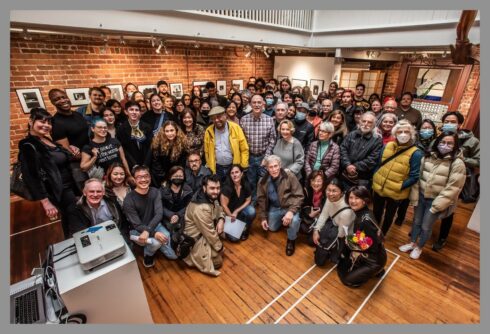
Both events drew a full house of attendees, along with a visit from a local art critic, putting an appropriate capstone on an impressive academic career for Lohmann, who has taught at CSM for 26 years and will retire at the end of the spring semester.
Art critic Jonah Raskin wrote: “CSM students represented at Canessa Gallery are talented and they’re becoming masters of both classic photographic printing processes from the 1880’s and sophisticated new technologies, and they’re keen observers of the world around them.”
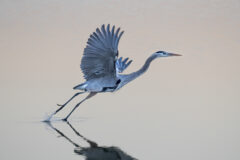 Student Imogene Bump says her photograph of a “Great Blue Heron was taken at Coyote Hills, near Fremont.” In addition to capturing the grace and elegance of the bird, she said: “this image is important to me because it is a representation of the wildlife that is all around us. The bay supports an incredible diversity of life, notably in all of its intertidal wetlands, bridging the marine and terrestrial ecosystems. The beauty and uniqueness of the Bay Area geography attracts all of us here, but the ever-increasing density of the human population poses a real challenge to native wildlife and their habitat is constantly under threat.”
Student Imogene Bump says her photograph of a “Great Blue Heron was taken at Coyote Hills, near Fremont.” In addition to capturing the grace and elegance of the bird, she said: “this image is important to me because it is a representation of the wildlife that is all around us. The bay supports an incredible diversity of life, notably in all of its intertidal wetlands, bridging the marine and terrestrial ecosystems. The beauty and uniqueness of the Bay Area geography attracts all of us here, but the ever-increasing density of the human population poses a real challenge to native wildlife and their habitat is constantly under threat.”
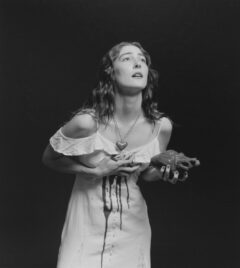 Student Gabrielle de Saint Andrieu noted, “I’m so grateful to have found the photography program at CSM. Not only do we have access to so many resources and opportunities, like this exhibit in a San Francisco gallery, but we also have teachers who are knowledgeable, talented, and excited to be there for us.”
Student Gabrielle de Saint Andrieu noted, “I’m so grateful to have found the photography program at CSM. Not only do we have access to so many resources and opportunities, like this exhibit in a San Francisco gallery, but we also have teachers who are knowledgeable, talented, and excited to be there for us.”
Gabrielle’s self-portrait is about a tragic failure of trust and her first heartbreak. “I was going through a rough breakup. I needed to work through my feelings using photography. During this breakup, I felt I had lost a part of myself. The photo is about how I was trying to save a relationship. While I didn’t physically rip my heart out, the pain was very real. Mr. Lohmann tells us that ‘great photographs are about more than aesthetic beauty—they reveal personal truths and communicate ideas and points of view.’”
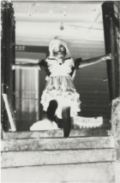 Student Patricia Leggett-Wantz said: “From our classroom critiques, an intriguing theme emerged: my work was about the figurative and literal imagery of women. The teacher encouraged me to create a larger series of images, so I place positive color slides into a photographic enlarger. It’s projected onto black and white photographic paper, when printed, becomes negative, in black and white, which is something very different from the original. This process of removing color and inverting the tonal values imbues each image with a touch of surrealism—otherworldly, yet hauntingly familiar.
Student Patricia Leggett-Wantz said: “From our classroom critiques, an intriguing theme emerged: my work was about the figurative and literal imagery of women. The teacher encouraged me to create a larger series of images, so I place positive color slides into a photographic enlarger. It’s projected onto black and white photographic paper, when printed, becomes negative, in black and white, which is something very different from the original. This process of removing color and inverting the tonal values imbues each image with a touch of surrealism—otherworldly, yet hauntingly familiar.
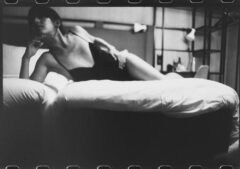 Another, Jackie Wang, was stuck in Paris, of all places, by the pandemic. COVID kept Wang in isolation for nine days and nine nights in a small room in an inexpensive hotel. “I went back to my hotel room and decided I would take self-portraits. Up until this point, I had no control over my situation. I couldn’t fly home, I wasn’t receiving help or direction from the US Embassy or American Consulate, I could hardly speak two words before having to pause and take two deep breaths, I had no control over the situation, and even worse, no control over my own body. So, in isolation – I made these photographs.”
Another, Jackie Wang, was stuck in Paris, of all places, by the pandemic. COVID kept Wang in isolation for nine days and nine nights in a small room in an inexpensive hotel. “I went back to my hotel room and decided I would take self-portraits. Up until this point, I had no control over my situation. I couldn’t fly home, I wasn’t receiving help or direction from the US Embassy or American Consulate, I could hardly speak two words before having to pause and take two deep breaths, I had no control over the situation, and even worse, no control over my own body. So, in isolation – I made these photographs.”
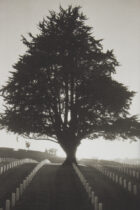 Walter Benitez, another photography student, said that “his photograph is a platinum print which is a process from 1865, is titled Soldiers Laid to Rest, that critic Jonah Raskin says “it depicts a cemetery with perfectly lined tombstones and an imperfect, yet beautiful tree that provides ample shade for the dead and buried.”
Walter Benitez, another photography student, said that “his photograph is a platinum print which is a process from 1865, is titled Soldiers Laid to Rest, that critic Jonah Raskin says “it depicts a cemetery with perfectly lined tombstones and an imperfect, yet beautiful tree that provides ample shade for the dead and buried.”
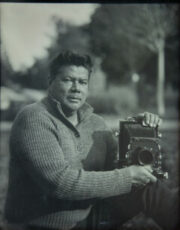 Shauna Mullins-Pellegrini’s portraits were created on a film that she made herself, using a gelatin emulsion formula from the early 1880s. It’s a multi-step process of brewing a light-sensitive emulsion using silver nitrate, salts, and gelatin. First, the emulsion is heated and poured onto a substrate; in this case, I used 8X10 black aluminum. Each batch takes about 6 hours to make from start to finish. Next, the plates are held in the dark to dry and cure for about 72 hours. Then the plates are ready to be loaded into wooden plate holders that are used to make images directly in the camera. This process is known as dry plate tintype, invented in 1871.
Shauna Mullins-Pellegrini’s portraits were created on a film that she made herself, using a gelatin emulsion formula from the early 1880s. It’s a multi-step process of brewing a light-sensitive emulsion using silver nitrate, salts, and gelatin. First, the emulsion is heated and poured onto a substrate; in this case, I used 8X10 black aluminum. Each batch takes about 6 hours to make from start to finish. Next, the plates are held in the dark to dry and cure for about 72 hours. Then the plates are ready to be loaded into wooden plate holders that are used to make images directly in the camera. This process is known as dry plate tintype, invented in 1871.
Critic Jonah Raskin points out that students benefit from one-on-one sessions with their teacher and fellow photographer, Richard Lohmann. “We’re learning from, and teaching one another, and also, as a class were converging,” Lohmann says. “We’re making it new by reviving the old and we’re growing our talents by exhibiting for the viewing public.”
Read Raskin’s full review and see more student work at The Art of Photography at Canessa Gallery.